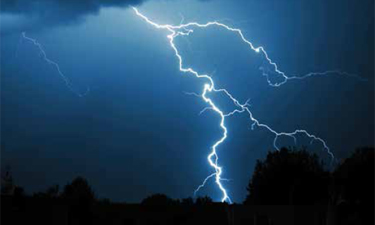 Each year in the United States, more than 400 people are struck by lightning. On average, 42 of those strikes prove fatal. Of importance to park and recreation professionals is that nearly half of these fatalities occur during organized sports or recreational activities.
Each year in the United States, more than 400 people are struck by lightning. On average, 42 of those strikes prove fatal. Of importance to park and recreation professionals is that nearly half of these fatalities occur during organized sports or recreational activities. To help reduce these fatalities, the National Athletic Trainers’ Association (NATA) recently published a lightning safety position statement for coaches, athletic trainers, parents, administrators and others involved in athletic or recreational activities.
“All individuals, particularly those who are in charge of sports and recreational activities, should be aware of the hazards, establish and follow appropriate guidelines, and ensure that those around them do so as well,” says Katie Walsh, Ed.D., ATC, East Carolina University, who chaired the position statement writing group for NATA.
The four NATA recommendations are:
1. Establish a lightning-specific emergency action plan for each venue
NATA recommends that each venue use a reliable means of monitoring the local weather and have a clear and understood decisionmaking chain of command. In addition, each venue should identify specific criteria for suspending and resuming outdoor activities. The prevailing norm is to suspend activities until 30 minutes after the last lightning strike or sound of thunder.
2. Ensure lightning and general weather awareness
This can be done by appointing a designated weather watcher or by subscribing to a commercial, real-time lightning-detection service.
3. Prepare large-event protocols
In addition to your general lightning emergency action plan, NATA recommends that venues establish specific plans for large-scale events. Some key items to consider include evacuation routes, the time needed to move a large crowd and the identification of safe shelters.
4. Provide first aid
During lightning storms, it is imperative that rescuers and emergency personnel ensure their own safety before venturing out to provide aid. If a situation arises, NATA recommends that patients be moved to a safe location as soon as possible to avoid further threats.
In addition to these safety guidelines, NATA reminds park and recreation personnel that the threat of lightning from thunderstorms is particularly prevalent from afternoon to early evening from late spring to early fall. According to published statistics, 90 percent of casualties occur during these time frames, with July being the highest month of incidence. Geographically, the areas with the most lightning activity are Florida, the Gulf states, the Mississippi and Ohio River valleys, the front range of the southern Rocky Mountains and parts of the Southwest.
According to Walsh, “It is important to communicate to everyone involved in an outdoor activity that safety comes first. There is no penalty or repercussion if they feel danger is impending and prefer to seek a safe location.”

